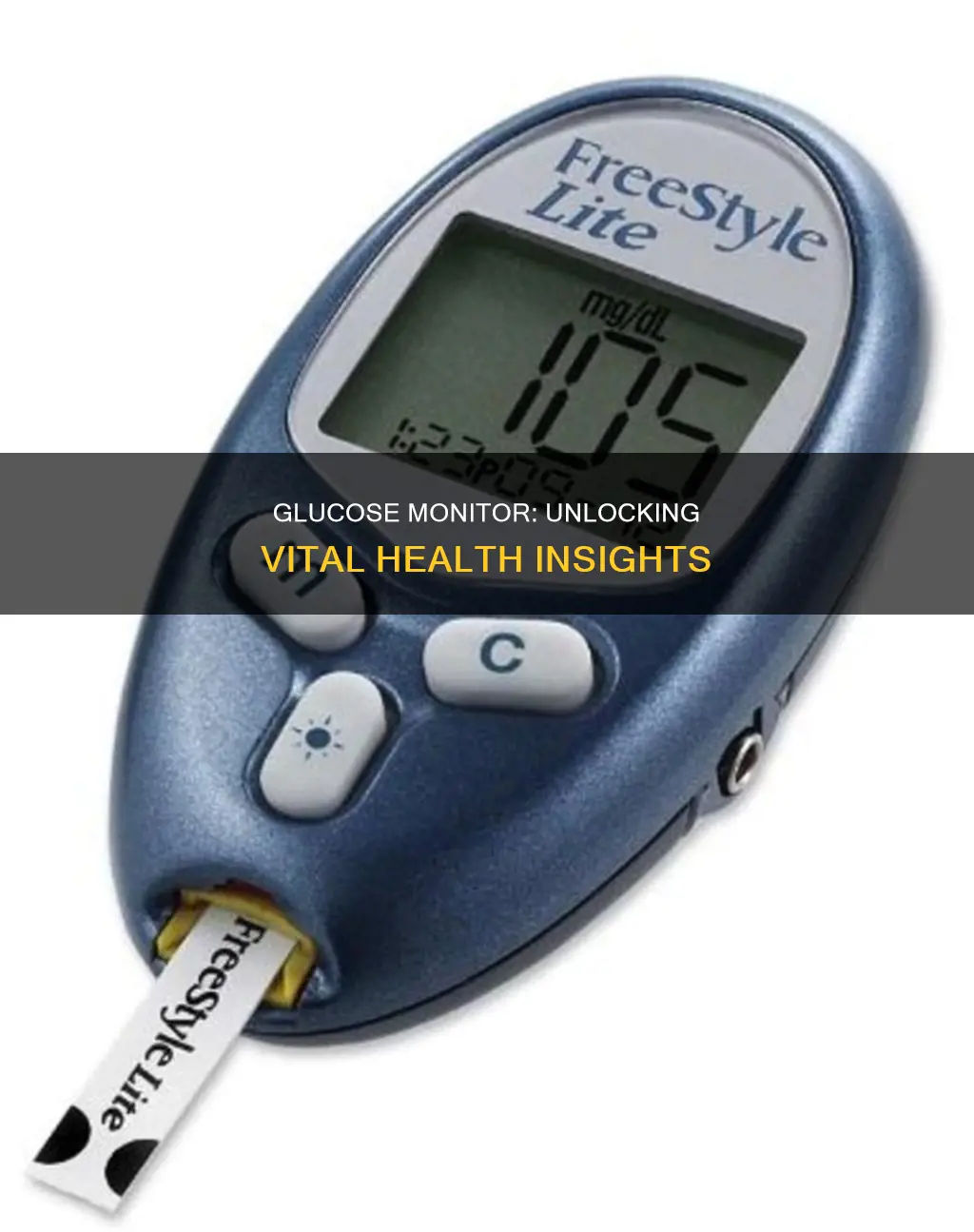
Glucose monitors, also known as continuous glucose monitors (CGM), are devices that help people manage their diabetes by tracking their glucose (or blood sugar) levels over time. They consist of a sensor inserted under the skin, a transmitter, and a smartphone app or receiver. The sensor measures glucose levels in the interstitial fluid between cells, which is very similar to the glucose level in the blood. The transmitter then sends this information wirelessly to the smartphone app or receiver, allowing users to track their glucose levels in real time. This can help users make informed decisions about their food and beverage consumption, physical activity, and medication. By keeping their blood glucose levels within a target range, people with diabetes can prevent health complications and improve their quality of life.
What You'll Learn

Glucose monitor components and how they work together
A continuous glucose monitor (CGM) is a device that helps people manage their diabetes by tracking their glucose (or blood sugar) levels over time. CGMs have three main components: a sensor, a transmitter, and a smartphone app, receiver, or insulin pump.
The sensor is a tiny piece of material that is inserted just under the skin, usually on the belly or arm, with an applicator. It measures glucose levels in the interstitial fluid (the fluid between cells) just under the skin, which is very similar to the glucose level in the blood. The sensor is usually disposable and must be replaced every few weeks, but some implantable sensors can last for months.
The second component of a CGM is the transmitter. This sends the glucose data from the sensor to a device where it can be viewed, such as a smartphone, an insulin pump, or a separate receiver device. The transmitter is either reusable or disposable, and it may be attached to the sensor or separate.
The third component is a smartphone app, receiver, or insulin pump. This technology displays the real-time glucose level and shows a graph of the history of the levels. It can also show whether the glucose level is trending up or down and how drastically. Some CGM devices can also send glucose information to a compatible insulin pump, which can deliver insulin when glucose levels rise.
Overall, CGMs provide valuable real-time information on glucose levels, helping people with diabetes make more informed decisions about their food, beverages, physical activity, and medications.
Autosync Monitor Size: Easy Steps for Quick Display Scaling
You may want to see also

How to insert a glucose monitor sensor
A continuous glucose monitor (CGM) is a device that helps people with diabetes manage their blood sugar levels. It consists of a sensor, a transmitter, and a smartphone app, receiver, or insulin pump. The sensor is inserted under the skin using an applicator with a needle that pierces the skin.
- Wash and dry your hands.
- Choose a site to insert the sensor. For children and adolescents, the sensor should be placed on the lower back or upper buttocks. For adults, the sensor is usually placed on the abdomen, at least three inches away from injection sites, the insulin pump infusion set, and the belly button. Avoid bony areas, areas with scars, hair, tattoos, or irritation, and do not use the same site twice in a row.
- Clean the chosen site with rubbing alcohol and let it dry.
- Prepare the sensor applicator by removing any paper tabs without touching the adhesive.
- Place the applicator horizontally on the skin and fold and break off the safety guard.
- Press the applicator button to insert the sensor.
- Remove and dispose of the applicator.
- Clean the transmitter with an alcohol wipe and let it dry.
- Insert the transmitter's tab into the matching slot on the sensor, snapping it into place. Start with the smaller end, then click the wider end into place.
- Rub around the adhesive three times to secure it.
- Depending on the type of CGM, there may be a "warm-up" time before the sensor starts sharing data. This can range from 30 minutes to two hours.
- Some CGMs may require a fingerstick blood glucose calibration before they start sharing data.
It is important to follow the specific instructions provided by the manufacturer of your CGM device and to seek guidance from a healthcare professional if needed.
Fixing LCD Dark Spots: Can They Be Removed?
You may want to see also

The difference between glucose monitor data and fingerstick blood glucose readings
Glucose monitors, also known as continuous glucose monitors (CGMs), are devices that help people with diabetes manage their blood sugar levels. They do this by tracking glucose (or sugar) levels over time, usually by measuring the glucose level in the interstitial fluid just under the skin.
CGMs differ from fingerstick blood glucose readings in several ways. Firstly, CGMs provide continuous data, measuring glucose levels around the clock, while fingerstick readings provide a single measurement at a specific point in time. This means that CGMs can show trends and patterns in glucose levels, whereas fingerstick readings provide a snapshot of the glucose level at that moment.
Secondly, CGMs measure glucose levels in the interstitial fluid under the skin, whereas fingerstick readings use a blood sample. This leads to a slight time lag in CGM readings compared to fingerstick readings, with interstitial glucose levels typically lagging behind blood glucose levels by a median of about 9 minutes. As a result, CGM readings may be less accurate, especially when glucose levels are changing rather than stable.
Thirdly, CGMs are often more convenient and comfortable for the user as they do not require finger pricking, which can be painful and inconvenient. CGMs are also less invasive and can be worn continuously for up to 14 days. However, CGMs may be more expensive and may require some technical knowledge to use and interpret the data effectively.
In terms of accuracy, both CGMs and fingerstick readings have their limitations. CGM readings can be affected by factors such as device calibration, sensor chemistry, and individual body chemistry. On the other hand, fingerstick readings can be influenced by issues with test strips, extreme temperatures, and substances on the skin. Therefore, it is generally recommended to use both methods in conjunction to ensure the most accurate results.
In conclusion, the main differences between CGM data and fingerstick blood glucose readings lie in their frequency, measurement method, accuracy, convenience, and cost. CGMs provide continuous data with minimal user effort, but may be less accurate and more expensive. Fingerstick readings provide accurate, timely measurements but require more frequent finger pricking and may not capture trends and patterns in glucose levels over time.
Choosing Monitors for a Cozy 9x9 Room
You may want to see also

Who can benefit from using a glucose monitor
Glucose monitors, also known as continuous glucose monitors (CGM), are primarily used by people with diabetes to help them manage their blood sugar levels. They can also be used by people with other conditions that impact glucose levels, such as certain glycogen storage diseases and insulinoma.
People with diabetes
People with type 1 or type 2 diabetes can benefit from using a CGM to monitor their blood glucose levels throughout the day and night. This can help them make more informed decisions about food, beverages, physical activity, and medication, and prevent health problems caused by diabetes. Doctors can prescribe CGMs for both adults and children with diabetes, with some models being suitable for children as young as two years old.
People with other conditions affecting glucose levels
CGMs can also be beneficial for people with certain glycogen storage diseases, which can cause frequent low blood sugar episodes, and insulinoma, a rare tumour that releases excess insulin and leads to severe low blood sugar.
People without diabetes or other glucose-related conditions
While CGMs have traditionally required a prescription, the recent FDA clearance of over-the-counter CGMs has made them more accessible to healthy people without a specific medical reason for monitoring their blood sugar. However, there is limited research on the benefits of CGMs for this population.
Possible reasons why someone without diabetes may want to monitor their blood sugar include:
- Detecting prediabetes: CGMs may allow for earlier diagnosis of prediabetes or diabetes, especially for those at higher risk due to family history or other factors.
- "Optimizing" blood sugar: Some CGM manufacturers suggest that monitoring blood sugar can help people make changes to keep it in an "ideal range", which they claim will improve health and performance. However, these notions have not been proven or well-studied.
- A sense of control: Having more information about one's body may provide a feeling of control over one's health.
- Curiosity: It can be tempting to gather information about our bodies, even if we're not sure what to do with it.
However, it is important to note that knowledge that is useless, redundant, or inaccurate may be harmful rather than empowering. For example, biologically insignificant drops in blood sugar may lead someone to snack more, potentially increasing their risk of developing diabetes.
The cost of CGMs, which can be several thousand dollars a year, is also a significant consideration, and it is unlikely that health insurers will cover CGMs for people without diabetes unless compelling evidence of their benefits emerges.
Calibrating LCD Monitors: Syncing Printer Output for Perfect Results
You may want to see also

The drawbacks of using a glucose monitor
While glucose monitors are a great way to keep track of your blood sugar levels, there are some drawbacks to using them. Here are some of the limitations and disadvantages of using a continuous glucose monitor (CGM):
Cost
CGMs and the supplies they require can be expensive, with initial costs ranging from $1,000 to $2,000. The cost of supplies can add up as well, with sensors needing to be replaced every 7 to 14 days, and other components requiring replacement over time. The total cost of supplies can be between $300 and $450 per month. While insurance may cover some of these costs, this will depend on your specific plan and qualifications.
Information Overload
The extensive information that CGMs provide can be overwhelming for some users. This information overload could worsen diabetes distress or burnout and may even trigger disordered eating. It is important to carefully consider how you will use the data provided by a CGM and how it might impact your mental health.
Alarm Fatigue
Depending on your settings, you may receive several alarms per day from your CGM. This can become distressing and lead to burnout, and it may even disrupt your sleep. It is important to balance the benefits of being alerted to high or low blood sugar with the potential negative impact on your overall well-being.
Always Attached to Your Body
All CGMs are an extra piece of hardware attached to your body, which can take some time to get used to. While there are discreet ways to cover them up, having a device attached to your body at all times can be annoying and inconvenient.
Issues with Adhesives
Some people experience allergic reactions or skin irritation from the adhesives used to attach the CGM sensor to the skin. This can be uncomfortable and may require additional treatments or medications to manage.
Inaccurate Readings
Issues with CGM sensors can sometimes lead to inaccurate readings, which could potentially affect diabetes management decisions. While CGM technology has improved in recent years, it is still not perfect, and there is often a lag between interstitial glucose levels and blood glucose levels. As such, it is important to confirm unexpected readings or those that don't match how your body feels with a traditional finger-stick test.
Overreliance on the Device
Overreliance on a CGM can reduce personal judgment and may even be dangerous if you rely solely on the sensor readings and ignore what your body is telling you. It is important to use the data from a CGM as a tool to help manage your diabetes, but not as the only source of information.
Monitoring Contractions: Tracking Time and Distance for Expectant Mothers
You may want to see also
Frequently asked questions
A continuous glucose monitor (CGM) is a device that automatically estimates your blood glucose level, also known as blood sugar, 24 hours a day. It consists of a sensor inserted under the skin, a transmitter, and a smartphone app or separate device to display the data.
The sensor measures glucose levels in the fluid between your cells, which is very similar to the glucose level in your blood. The transmitter then sends this information wirelessly to a smartphone app or separate device, where you can view your glucose level in real time and see how it has changed over time.
Glucose monitors are primarily designed for people with diabetes, particularly those who need insulin to manage their condition. However, they can also be used by people without diabetes who want to understand how their diet and physical activity affect their blood glucose levels. Additionally, healthcare providers may recommend CGMs for other conditions that impact glucose levels, such as certain glycogen storage diseases and insulinoma.
Using a glucose monitor can help you manage your glucose levels and make more informed decisions about food, beverages, physical activity, and medication. It can also reduce the number of fingerstick checks required and alert you to high or low glucose levels, helping to prevent emergencies. For people with diabetes, CGMs can help prevent health problems caused by the condition and improve quality of life.







